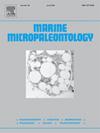Non-pollen palynomorphs as indicators of local environmental conditions in a Neotropical Estuary (Northeast Brazil)
IF 1.5
4区 地球科学
Q2 PALEONTOLOGY
引用次数: 0
Abstract
Non-pollen palynomorphs (NPPs) are organic-walled microfossils derived from diverse aquatic and terrestrial organisms, frequently observed in palynological studies. This study documents the distribution of NPPs in surface sediment samples from the two main rivers of Camamu Bay (Northeast Brazil), analyzed to explore their response to estuarine environmental and nutritional gradients. Using standard palynological techniques, 69 NPP taxa were identified, spanning 40 divisions, including dinoflagellates, foraminiferal linings, chlorophytes, cyanobacteria, ciliates, amoebozoans, scolecodonts, zoological fragments, and fungal spores. Assemblages were dominated by fungal spores across most stations. Distinct environmental gradients were reflected in NPP distribution, for instance upstream stations with low salinity (3 psu) and high nutrient ratios favored chlorophytes, while downstream stations with higher salinity (up to 35 psu) and lower N:P ratios (<40 μM) were dominated by foraminiferal linings. Multivariate statistic analyses revealed that salinity and nutrient stoichiometry were significant drivers of assemblage composition. These findings highlight the utility of NPPs as indicators of environmental and biogeochemical conditions, particularly in low-latitude estuarine systems, and underscore their potential applications in paleoecological reconstruction.
巴西东北部新热带河口非花粉型孢粉形态对当地环境条件的指示作用
非花粉孢粉微化石(NPPs)是来源于水生和陆生生物的有机壁微化石,在孢粉学研究中经常观察到。本研究记录了巴西卡马木湾(Camamu Bay)两条主要河流表层沉积物样品中核动力物质的分布,并分析了它们对河口环境和营养梯度的响应。使用标准孢粉学技术,共鉴定出69个NPP分类群,跨越40个门类,包括鞭毛虫、有孔虫、绿藻、蓝藻、纤毛虫、变形虫、scolecodonts、动物碎片和真菌孢子。大多数站点的组合以真菌孢子为主。NPP分布具有明显的环境梯度,低盐度(3 psu)和高营养比的上游站站有利于绿藻,而高盐度(高达35 psu)和低N:P比(<40 μM)的下游站站则以有孔虫为主。多变量统计分析表明,盐度和营养化学计量学是群落组成的重要驱动因素。这些发现突出了核电厂作为环境和生物地球化学条件指标的效用,特别是在低纬度河口系统中,并强调了它们在古生态重建中的潜在应用。
本文章由计算机程序翻译,如有差异,请以英文原文为准。
求助全文
约1分钟内获得全文
求助全文
来源期刊

Marine Micropaleontology
地学-古生物学
CiteScore
3.70
自引率
15.80%
发文量
62
审稿时长
26.7 weeks
期刊介绍:
Marine Micropaleontology is an international journal publishing original, innovative and significant scientific papers in all fields related to marine microfossils, including ecology and paleoecology, biology and paleobiology, paleoceanography and paleoclimatology, environmental monitoring, taphonomy, evolution and molecular phylogeny. The journal strongly encourages the publication of articles in which marine microfossils and/or their chemical composition are used to solve fundamental geological, environmental and biological problems. However, it does not publish purely stratigraphic or taxonomic papers. In Marine Micropaleontology, a special section is dedicated to short papers on new methods and protocols using marine microfossils. We solicit special issues on hot topics in marine micropaleontology and review articles on timely subjects.
 求助内容:
求助内容: 应助结果提醒方式:
应助结果提醒方式:


